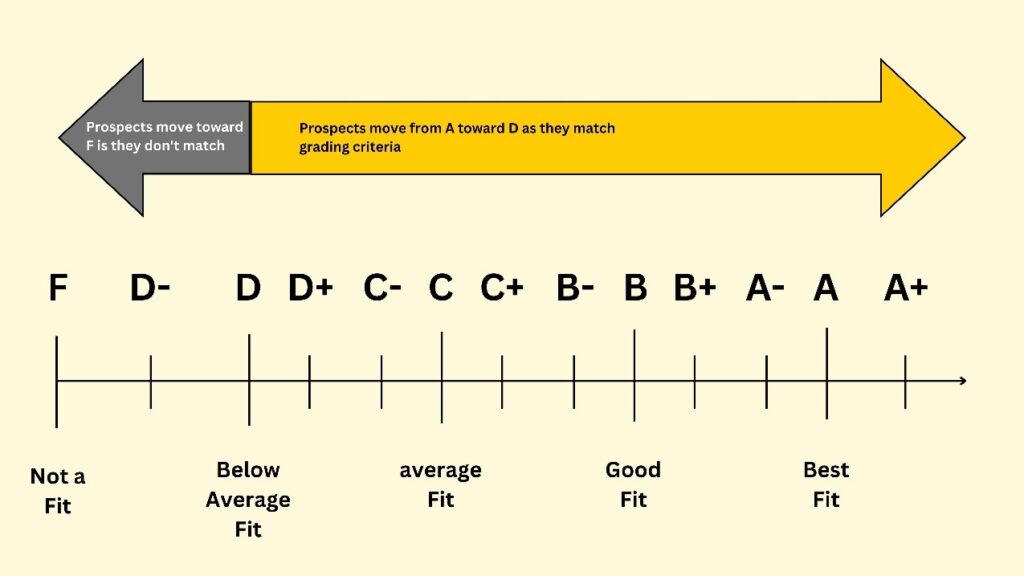Crafting Effective Ideal Customer Profiles and Grading Strategies
What is Ideal Customer Profile (ICP)?
An ICP is a detailed description of the type of customer or client that a business or organization considers to be the most valuable and well-suited for advertising, marketing, and sales.
– It represents the characteristics, attributes, and traits of the account’s who are most likely to benefit from what the business offers and who are also more likely to become loyal, long-term customers.
– ICP finds best fit targets from your existing database for marketing and sales.
– Ideal Customer Profile plays a pivotal role in shaping both marketing strategy and sales pitching and efforts more effectively.
Creating an Ideal Customer Profile involves analysing and understanding various factors, such as:
1. Demographics: – This includes information such as location, job title, company size, and industry etc.
2. Firmographics: – Information about the company or organization the customer works for, including company size, annual revenue, and industry etc.
3. Technographics: – Technographics data gives you insights into the technology tools, software, and solutions that a company is using and how they’re applied, the methods of implementation, and how widely these technologies are adopted within the organization.
4. Buying Behaviour: – The buying behaviour of customers within your Ideal Customer Profile is essential for effective marketing, sales, and overall business strategies.
5. Existing Customer Data: – Analysing data from your existing customer base can provide insights into the characteristics of customers who have been the most successful and satisfied.
ICP requires research, analysis, and feedback from both your sales and marketing teams. Regularly revisiting and refining your ICP based on real-world data and feedback will help ensure that your targeting strategies remain effective and aligned with your target market’s evolving needs.
To understand the ICP we first need to learn few key terms used in Pardot to create ICP:
Profile: – Profile in Pardot refers to a set of characteristics and settings that you define for a specific group of people you’re targeting with your marketing efforts. There are two key facts to learn: Each prospect has one profile. Each profile is made up of multiple criteria, and the grade adjustment for each value.
Prospect: – Prospect refers to an individual or company that has shown some level of interest in your products or services, but they have not yet been fully qualified as a lead or converted into a customer. Prospects are essentially contacts that are part of your marketing and sales funnel, and Pardot provides tools to help you engage, nurture, and qualify these prospects until they are ready to become leads or customers.
Criteria: – In marketing automation platform by Salesforce, “criteria” generally refers to the conditions or rules that you can define to segment or categorize your prospects, leads, or contacts. These criteria are used to determine which prospects meet certain qualifications and should be included in specific marketing or sales activities.
– In this point construction base few points like number of projects, project category (residential, commercial, mixed), project built up area, project end date, State, apartment’s, blogs etc.
Grading: – In “grading” refers to the process of assigning a specific grade to prospects based on their characteristics and attributes. Grading helps you evaluate the quality of your prospects and prioritize them for sales outreach. It’s a way to quantitatively measure how well a prospect matches your ideal customer profile and how likely they are to convert into a customer.
– Grades can be adjusted positively or negatively by (⅓, ⅔, 1 OR 3/3). Grades can be increased or decreased by ⅓, ⅔ or 3/3 of a letter grade. The weights help determine how strong an indicator each criterion is in determining lead quality.
– Grading is a valuable tool in Pardot because it helps marketing and sales teams collaborate more effectively.
– A prospect can get anywhere from an F to an A+ – ranging from worst to best.

Automation Rules – Automation rules allow you to perform certain marketing and sales actions based on criteria that they specify. Automation rules continuously look for prospects who match the rule criteria.
– You can set automation rules to repeat if you select the repeat rule checkbox. This option lets you control how many times the rule can match a prospect.
– Automation rules are built from criteria and actions. The criteria are what sorts through your database for you, and then the action is applied to those prospects matching your criteria.

1. Conditions: These conditions can be based on prospect attributes, behaviours, lead scores, or other criteria that you define. For example, you could set up a rule to trigger when a prospect opens a specific email or visits a particular landing page.
2. Actions: – Once the conditions are met, automation rules execute predefined actions. These actions can include tasks like sending an email, assigning a prospect to a sales representative, adding, changing lead status, adjusting lead scores, and more.
In the realm of modern marketing and sales, creating a well-defined ICP is crucial for success. Grading prospects and employing automation rules, as in platforms like Pardot, enhances prioritization and engagement. Regular refinement based on real-world data ensures alignment with evolving market dynamics, allowing for effective strategies and increased conversions.